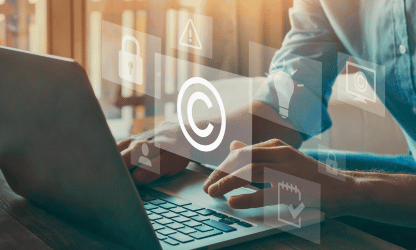Protecting your intellectual property and your brand’s reputation in today’s online climate is one of the key concerns of companies and creators. But why is this so important and how do you make sure your online brand protection strategy is robust? Let’s find out.
What is Intellectual Property?
Intellectual Property (IP) refers to creations of the mind, such as inventions, literary and artistic works, designs, and symbols. It’s a legal term used to describe the rights that creators have over their intellectual works. These rights allow creators to control who can use their creations and how.
There are several types of intellectual property:
- Trademarks: Words, phrases, symbols, or designs that identify and distinguish the source of goods or services.
- Copyrights: Protect original works of authorship, such as literature, music, drama, and art.
- Patents: Grant exclusive rights to inventors for their inventions.
- Industrial Designs: Protect the appearance of a product.
Protecting your intellectual property (IP) is vital for several reasons:
- Competitive Advantage: IP gives you a unique edge over competitors. It prevents others from copying your ideas, designs, or processes.
- Financial Gain: IP can be a valuable asset. You can license, sell, or commercialise it to generate revenue.
- Brand Reputation: Strong IP helps build a strong brand identity. Customers trust brands that protect their intellectual property.
- Investment Attraction: Investors are often drawn to businesses with a solid IP portfolio. It demonstrates innovation and potential for growth.
- Legal Protection: IP rights provide legal recourse if someone infringes on your work.
- Business Valuation: IP contributes significantly to a business’s overall value.
Essentially, protecting your IP and brand helps safeguard your business and maximise its potential. Brand protection preserves the value and reputation of a brand by protecting its intellectual property rights. This includes monitoring for infringements, taking legal action when necessary, and implementing strategies to deter future infringements such as counterfeiters, copycats, and other bad actors illegally using a company’s brand name, identity, and intellectual property.
Why is a Brand Protection Strategy Important for a New Business?
A brand protection strategy is paramount for new businesses as it establishes a strong foundation for future growth. In the competitive marketplace, a new business must differentiate itself and build trust with consumers rapidly. Protecting your brand identity, including your logo, name, and unique selling points, is crucial. A robust brand protection strategy safeguards against counterfeit products, domain name hijacking, and unauthorised use of your intellectual property. By preventing these issues from the outset, you protect your reputation, customer trust, and potential investment opportunities. Additionally, it allows you to focus on growth and innovation without the distraction of brand infringement challenges.
Do I Possess Online Assets Which Need To Be Protected?
Understanding whether you possess assets requiring online protection is crucial for safeguarding your business. Begin by conducting a comprehensive inventory of your intellectual property, encompassing trademark, copyright, patent, and design. Analyse your business model, identifying any unique processes or proprietary information that could be valuable to competitors. Evaluate your online presence, assessing the sensitivity of information shared on your website or social media platforms. Consider the potential financial and reputational damage that could arise from unauthorised access or misuse of your assets. By conducting a thorough assessment, you can identify vulnerabilities and prioritize protection measures accordingly.
Collaborating with legal experts specialising in intellectual property can provide invaluable guidance in determining the assets worthy of protection. They can analyse your business operations, identify potential risks, and recommend appropriate safeguards. Consider consulting with cybersecurity professionals to assess the digital landscape and identify potential threats to your online assets. By combining internal expertise with external guidance, you can develop a comprehensive understanding of your protection needs.
Remember that the value of your assets may evolve over time. Regularly review and update your assessment to account for new products, services, or digital initiatives. Stay informed about emerging threats and industry best practices to ensure your protection measures remain effective. By maintaining a proactive approach to asset protection, you can mitigate risks and safeguard your business’s future.
How Do I Protect My Brand Online?
Now that we’ve looked at IP and the importance of online brand protection, you might be asking, “Where do I start?”. Let’s walk through some key steps you should consider when formulating a brand protection strategy.
1. Identify Your Intellectual Property (IP)
- Inventory: Conduct a thorough assessment of your brand’s IP, including trademark, copyright, patent, and Design.
- Prioritise: Determine which assets are most critical to your business and require the highest level of protection.
2. Conduct a Risk Assessment
- Threat Identification: Identify potential threats to your brand, such as counterfeiting, domain squatting, and social media impersonation.
- Vulnerability Analysis: Evaluate your brand’s vulnerabilities to these threats.
3. Develop a Protection Plan
- IP Registration: Ensure all valuable IP is registered and protected in all key territories.
- Monitoring: Establish a system to monitor online platforms for trademark infringement, copyright violations, and other threats.
- Response Plan: Create detailed procedures for handling infringements, including takedown requests and legal actions.
- Employee Training: Educate employees about IP protection and their role in safeguarding the brand.
4. Implement Protection Measures
- Technology: Utilise brand protection software and tools for monitoring, detection, and response.
- Partnerships: Collaborate with anti-counterfeiting organisations and law enforcement.
- Domain Protection: Register domain names related to your brand to prevent cybersquatting.
- Social Media Management: Implement strong social media guidelines and monitoring.
5. Continuous Monitoring and Adaptation
- Regular Reviews: Continuously assess the effectiveness of your brand protection strategy.
- Stay Informed: Keep up-to-date with the latest threats and protection methods.
- Adapt: Modify your strategy as needed to address emerging challenges.
By following these steps, you can create a robust online brand protection strategy that safeguards your brand’s reputation, intellectual property, and overall business success.
What Tools and Services Are There to Help Me Protect my Brand Online?
The digital landscape offers a variety of tools and services to help protect your brand online. Here are some key categories:
Monitoring Tools
Social Media Listening Tools: These platforms track mentions of your brand across various social media platforms, helping you identify potential issues early on. Examples include Hootsuite, and Mention.
Website Monitoring Tools: These tools monitor your website for changes, downtime, and security breaches. Options include Uptime Robot and Pingdom.
Domain Monitoring Tools: These services alert you to domain name registrations that might infringe on your brand. Examples include DomainTools and MarkMonitor.
Intellectual Property Protection Services
Trademark and Copyright Registration: This is the foundation of brand protection. Consult with an attorney to register your trademarks and copyrights.
Trademark and Copyright Search Services: These services help you determine if your desired brand name or logo is available for registration.
Anti-Counterfeiting Services: Specialised firms can help you identify and combat counterfeit products.
Investigative Firms: These professionals can help you gather evidence of brand infringement and build a case for legal action.
Other Essential Tools
Google Alerts: Set up alerts for your brand name, keywords, and competitors to stay informed.
Social Media Management Tools: These can help you manage your brand’s social media presence and respond to issues promptly.
Remember: The best approach to brand protection often involves a combination of tools and services tailored to your specific needs. Consider consulting with a brand protection expert to develop a comprehensive strategy.
How To Guides
We’ve developed a comprehensive list of How To Guides to help you enforce your own brand protection across a number of common 3rd party seller sites, social media and independent platforms.
How Much Does Online Brand Protection Cost?
The cost of online brand protection is variable and depends on several factors. The scope of protection, desired level of service, level of threat, and chosen provider all influence the final price. Basic monitoring tools can be free or inexpensive, while comprehensive solutions with legal support can cost thousands annually. Trademark and copyright registration fees are additional expenses. It’s essential to weigh the potential costs against the benefits, as strong brand protection can prevent significant financial losses due to counterfeiting and reputation damage.
Consider the long-term perspective when budgeting for brand protection. While initial costs might seem high, the protection of your brand’s reputation and intellectual property is an investment that can yield substantial returns.
When Should I Look Into Brand Protection?
Ideally, consulting with a brand protection company like SnapDragon should be considered as early as possible in the business lifecycle. While it might seem premature, we can assist you in proactively safeguarding your brand from the outset and prevent significant issues later on. As soon as you have a concept or product that you believe has market potential, it’s worth exploring brand protection options. This allows you to register trademarks, copyrights, or patents early, establish a strong brand identity, and implement preventative measures to protect your intellectual property.
By taking these steps from the beginning, you’re laying a solid foundation for your business’s future growth and success. Even if you’re an established business experiencing brand protection challenges, we can help you develop a robust strategy to address current issues and prevent future problems.
Contact us today and book your free consultation.




